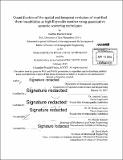| dc.contributor.advisor | Andone Lavery and W. Rockwell Geyer. | en_US |
| dc.contributor.author | Fincke, Jonathan Randall | en_US |
| dc.contributor.other | Woods Hole Oceanographic Institution. | en_US |
| dc.date.accessioned | 2015-07-17T19:53:47Z | |
| dc.date.available | 2015-07-17T19:53:47Z | |
| dc.date.copyright | 2015 | en_US |
| dc.date.issued | 2015 | en_US |
| dc.identifier.uri | http://hdl.handle.net/1721.1/97855 | |
| dc.description | Thesis: S.M., Joint Program in Oceanography/Applied Ocean Science and Engineering (Massachusetts Institute of Technology, Department of Mechanical Engineering; and the Woods Hole Oceanographic Institution), 2015. | en_US |
| dc.description | Cataloged from PDF version of thesis. | en_US |
| dc.description | Includes bibliographical references (pages 54-56). | en_US |
| dc.description.abstract | The spatial and temporal evolution of stratified shear instabilities is quantified in a highly stratified and energetic estuary. The measurements are made using high-resolution acoustic backscatter from an array composed of six calibrated broadband transducers connected to a six-channel high-frequency (120-600 kHz) broadband acoustic backscatter system. The array was mounted on the bottom of the estuary and looking upward. The spatial and temporal evolution of the waves is described in terms of their wavelength, amplitude and turbulent dissipation as a function of space and time. The observed waves reach an arrested growth stage nearly 10 times faster than laboratory and numerical experiments performed at much lower Reynolds number. High turbulent dissipation rates are observed within the braid regions of the waves, consistent with the rapid transition to arrested growth. Further, it appears that the waves do not undergo periodic doubling and do not collapse once their maximum amplitude is reached. Under some conditions long internal waves may provide the perturbation that decreases the gradient Richardson number so as to initiate shear instability. The initial Richardson number for the observed instabilities is likely between 0.1 and 0.2 based on the slope and growth rate of the shear instabilities. | en_US |
| dc.description.statementofresponsibility | by Jonathan Randall Fincke. | en_US |
| dc.format.extent | 95 pages | en_US |
| dc.language.iso | eng | en_US |
| dc.publisher | Massachusetts Institute of Technology | en_US |
| dc.rights | M.I.T. theses are protected by copyright. They may be viewed from this source for any purpose, but reproduction or distribution in any format is prohibited without written permission. See provided URL for inquiries about permission. | en_US |
| dc.rights.uri | http://dspace.mit.edu/handle/1721.1/7582 | en_US |
| dc.subject | Joint Program in Oceanography/Applied Ocean Science and Engineering. | en_US |
| dc.subject | Mechanical Engineering. | en_US |
| dc.subject | Woods Hole Oceanographic Institution. | en_US |
| dc.subject.lcsh | Underwater acoustics Instruments | en_US |
| dc.subject.lcsh | Underwater acoustic telemetry | en_US |
| dc.title | Quantification of the spatial and temporal evolution of stratified shear instabilities at high Reynolds number using quantitative acoustic scattering techniques | en_US |
| dc.type | Thesis | en_US |
| dc.description.degree | S.M. | en_US |
| dc.contributor.department | Joint Program in Oceanography/Applied Ocean Science and Engineering | en_US |
| dc.contributor.department | Woods Hole Oceanographic Institution | en_US |
| dc.contributor.department | Massachusetts Institute of Technology. Department of Mechanical Engineering | |
| dc.identifier.oclc | 913747272 | en_US |
